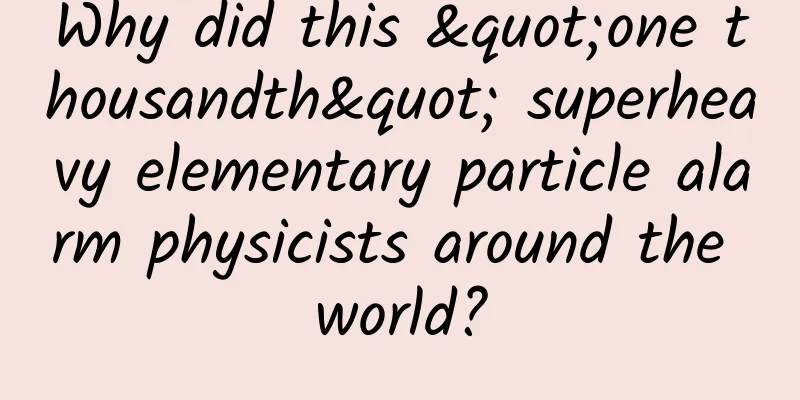Why did this "one thousandth" superheavy elementary particle alarm physicists around the world?

|
|||| Written by Zhang Hao (Associate Researcher, Theoretical Physics Laboratory, Institute of High Energy Physics, Chinese Academy of Sciences) Editor/Ding Lin Li Yunfeng Recently, the CDF experiment group at the Fermi National Laboratory in the United States announced the latest analysis results of the mass measurement of the W boson of the Standard Model. Since the difference with the theoretical expectation value of the Standard Model of particle physics is more than 7 standard deviations, this result has attracted the attention of physicists. What is the W boson? How is its mass measured? What does the deviation found in the new study mean? This article attempts to briefly introduce these questions to readers. ◇ ◇ ◇ Who is W? In 1896, French physicist Henri Becquerel discovered the phenomenon of natural radioactivity. Soon people found that there are three types of rays with different penetrating powers in natural radioactivity - alpha rays, beta rays and gamma rays. ▲By studying the deflection of radiation in a magnetic field, physicists discovered that radiation includes three types: positively charged, negatively charged, and uncharged, and named them alpha rays, beta rays, and gamma rays. The process of emitting beta rays is a decay process, so it is called beta decay. (Image source: People's Education Press textbook) For the "classical" physicists at the end of the 19th century, this was a completely new phenomenon, and many of its properties were puzzling. Its study opened up the history of mankind's understanding of various elementary particles and their interactions for more than a century. Today, physicists who have mastered the theoretical tools of relativistic quantum field theory have been able to understand natural radioactivity, especially the origin of beta rays. The generation of beta rays is caused by another new interaction different from gravity and electromagnetism - weak interaction. Similar to the electromagnetic force between particles with "electrical charge", if some particles have so-called "weak charge", there will be "weak force" between them. Beta rays in natural radioactivity are simply the result of a neutron in the nucleus "decaying" into a proton, an electron and a (anti-electron) neutrino under the action of weak force. ▲Schematic diagram of neutron decay (Source: science.org) One point that is easy to confuse people is that (in fact, physicists have been confused for a while in history): this decay does not mean that the neutron is composed of these three particles. It is like an electron turning in an electromagnetic field. Although it will radiate electromagnetic waves (photons), this does not mean that the original electron is composed of the later electron and the radiated photons. Similarly, we should not think of neutrons as a "small solar system" composed of protons, electrons and neutrinos revolving around each other. The above (inaccurate) analogy can be continued. Physicists now know that neutrons, protons, electrons and neutrinos all carry weak charges. We can loosely imagine that neutrons "radiate" electrons and neutrinos, and themselves become another weakly charged particle - protons. Unfortunately, such a simple description is not allowed in the well-behaved quantum field theory. Physicists spent decades trying to understand the various difficulties, and finally realized that since neutrons can only "throw out" one particle at a time, there must be a new particle in the process of neutron decay. This new particle is the so-called W boson. The capital letter W comes from the "Weak" in weak interaction. ◇ ◇ ◇ W's "theoretical weight" Speaking of Fermilab's latest results not matching theoretical expectations, how much does theory predict the W boson should weigh? It's more than 85 times the mass of a neutron! Isn't W "thrown out" by the neutron? How can it be heavier than the neutron? ▲Research on the "superheavy" W boson was published as the cover article of Science in early April In fact, this is precisely the result of the "uncertainty principle" of quantum physics. Under the action of weak force, a neutron "throws out" a W boson and becomes a proton, and the W boson can also "throw out" an anti-electron neutrino and become an electron. Although a neutron "throwing out" a W boson that is much heavier than itself violates the law of conservation of energy, according to the "energy-time uncertainty relation" in quantum physics, as long as this process occurs in a short enough time, it will not "show" any effect that violates the conservation of energy. Physicists estimated the mass of the W boson by calculating the decay rate of the neutron - this is the earliest information we have about the mass of the W boson. Today, various particles in the standard model of particle physics have been experimentally observed, and particle physicists have made a large number of measurements of the interaction properties of these particles, some of which are very precise. There is no direct measurement of the mass of the W boson in these observations, but they depend in principle on only a few (at most a dozen) physical parameters. Physicists can infer the mass of the W boson by calculating these observations. In other words, if the standard model is correct, the mass of the W boson should be this large to explain the experimental data of particle physics mentioned above - this is the origin of the standard model's expectation value for the mass of the W boson. Today, this expectation value is 80357MeV, which is 85.644 times the mass of the proton. The accuracy of this estimate is as high as 0.75 ten thousandths! ▲The Collider Detector (CDF) at the Fermi National Accelerator Laboratory in the United States collected a large amount of high-energy particle collision data between 1985 and 2011. The picture shows the CDF being dismantled (Photo credit: Fermilab) ◇ ◇ ◇ How can the mass of W be measured "directly"? Although the Standard Model has predicted the mass of the W boson very accurately, particle physicists still need to measure it "directly" as an important physical quantity. If the measurement result is consistent with theoretical expectations, it will be a great success of the Standard Model. If it is inconsistent, it may be a signal from "new physics" beyond the Standard Model. It is very difficult to measure the mass of elementary particles. Compared with macroscopic objects, they are too small and too light to be directly put on the scale. On the other hand, many elementary particles decay rapidly. Fortunately, for such decaying particles (including W bosons), physicists can record the motion information of other particles produced by their decay in particle detectors, and then recombine the energy and momentum of these particles to restore the information of the particles before decay, thereby calculating their mass. In principle, this method of measuring the mass of unstable particles is somewhat similar to the method suggested by Xu Chu in the story of "Cao Chong Weighing the Elephant": cut the elephant into eight pieces, weigh each piece, and then add them up. ▲This computer image shows the event of the W boson decaying into a positron (magenta block, lower left) and an undetected neutrino (yellow arrow) in the CDF detector (Image source: nature.com) Another difficulty in measuring the mass of the W boson is that one of the two particles of its decay product is a neutrino, a particle that cannot be captured and recorded by the detectors of the collider. Therefore, we cannot get information about every piece of "meat" of the "elephant". Fortunately, physicists can still infer the mass of the W boson by using the statistical distribution of the motion state of another decay product, the electron (or muon). Based on the above principles, experimentalists from the CDF experimental group conducted a very careful analysis of the "massive" experimental data stored on the Tevatron collider at the Fermi National Laboratory in the United States, which had been shut down more than a decade ago. They ultimately obtained the most accurate direct measurement result of the W boson mass in the world: 80433.5 MeV. The measurement accuracy reached an astonishing 1.17 ten-thousandths! ◇ ◇ ◇ How to explain the anomalous results? Through simple calculations, we can find that there is a gap of about one thousandth (76.5 MeV) between the theoretical expectation of the W boson mass (80357 MeV) and the latest experimental result (80433.5 MeV). This gap may seem insignificant, but both the theoretical expectation value and the experimental measurement value have an error of about one ten-thousandth. ▲The research results are based on trillions of CDF "proton-antiproton" collision experimental data (Image source: Baylor University) Using the customary expression in the particle physics community, the scholars said that the measurement results deviated from the prediction of the Standard Model by "seven standard deviations." What does 7 standard deviations mean? It means that assuming that there are no errors in the theoretical calculations and measurement results, no new physics beyond the existing theory, and that the error estimates of both are reasonable, then the probability of such a result caused purely by statistical fluctuations and random experimental deviations falls outside the area of 7 standard deviations of the center value of the normal distribution. Readers familiar with statistics can use simple calculation tools to obtain: this probability is only 0.00000000000256 (if the calculator is not accurate enough, it will directly report 0). This probability can also be interpreted in reverse: the probability that the experimental observation is wrong, there is new physics, or there is a problem with the error estimate is as high as 99.99999999999754%. ▲In a normal distribution, the greater the standard deviation of the data from the median (μ), the smaller the probability of occurrence. For example, the probability of data outside the standard deviation of 3σ occurring is only about 0.27% (Image source: mit.edu) In the particle physics community, the deviation standard required to overturn mature theoretical results is generally 5 standard deviations. That is to say, when the deviation between the observational results and the theory reaches 5 standard deviations (or higher), physicists will say "new physics has been discovered", otherwise it can only be listed as a "potential" problem. The selection of the "5 times" boundary involves various considerations, including industry customs, historical experience, and so on. However, as long as we realize that such a high deviation means that something must have gone wrong, and it is unlikely to be a statistical fluctuation, it will be fine. So what went wrong? There are several possibilities: (1) The existence of new physics: This is of course the most exciting explanation. In fact, within just a few days after the experimental article was published online, dozens of theoretical articles have attempted to explain this deviation with new physical effects beyond the standard model. There are successful examples, which also show some challenges that this deviation poses to new physical models. Of course, since the experimental results of other experimental measurements of the mass of the W boson to date (within the allowable error range) are consistent with the theoretical expectation value of the standard model, all these "new physics" models still need to answer a question, that is, why only the CDF experimental results show this mass deviation. ▲The latest measurement results released by CDF are extremely accurate. In comparison, the measurements of earlier experiments are closer to the theoretical predictions of the Standard Model (Image source: Science) (2) There are errors in the calculation or experimental measurement of the expectation value of the Standard Model: In history, there have indeed been strange results such as "superluminal neutrinos" that reached 6 times the standard deviation, which were finally proved to be low-level experimental errors. However, at present, the possibility of these two situations in this result is extremely low. (3) The error of the result is underestimated: As mentioned above, the measurement results of the CDF experiment do not directly give the mass of the W boson. Instead, it is necessary to compare the distribution of certain properties of the decay product particles collected by the detector with the distribution given by the theory under different W boson mass parameters. The W mass when the two are most consistent is the measurement result. Is there an underestimated error in this process? This is currently a question that theorists are more concerned about. After all, this is a result with an accuracy of one ten-thousandth of an order of magnitude. Any insignificant error at the accuracy level of one percent or one thousandth may appear and cause a major impact. The measurement result of the CDF experimental group is another important progress in the precision measurement experiment of particle physics. In the future, no matter which of the above explanations for the final results is given, it will deepen the scientific community's understanding of the physics behind it. On the other hand, people also expect more precise experiments to be able to independently measure the mass of the W boson with higher accuracy and less uncertainty. This task can only be left to future lepton colliders such as CEPC and FCC-ee. Produced by: Science Central Kitchen Produced by: Beijing Science and Technology News | Beijing Science and Technology Media Welcome to share to your circle of friends Reproduction without authorization is prohibited |
Recommend
Practical information: Zhihu promotion and traffic diversion only need to do these 3 things
Zhihu not only has a large amount of traffic, but...
How does a frog's slippery tongue catch a fly?
When it comes to frog hunting, the following scen...
ReactiveCocoa is so useful that I can’t stop using it
[[145435]] Foreplay I personally highly recommend...
During the Spring Festival, if you have a sudden heart attack, which emergency medicine should you choose? Check out the expert summary!
Cardiologists are always busy during the Spring F...
Brand promotion: 3 golden rules for creating hot products
For a long time, many people have had certain mis...
Sony XB60 speakers - let life rock with music, let life be agitated with the rhythm
We often see in movies and TV shows that when our...
Starting from the account name, we will teach you how to operate a profitable Xiaohongshu account step by step
: : : : : : : : : : : : : : : : : : : : : : : : : ...
You in the mirror or you in your phone, which one is the real you?
Mirror, mirror, tell me, who is the most beautifu...
Promotion methods of APP new media marketing!
The basic tone of the APP operation and promotion...
Putting this kind of film on your phone will really ruin your eyes... Urgent reminder →
A user posted that after using a privacy film in ...
How to promote on Xiaohongshu? Xiaohongshu promotion tips!
In fact, most of the Xiaohongshu merchants are mo...
Xunlei iOS version is back on the shelves! Is its function so weak after its resurrection?
After much anticipation, Xunlei iOS version is fi...
What are the small details when running an event?
Before writing this article, I was particularly c...
An inventory of 3 common ways to play in social networks!
There are many different ways to play in a commun...
The evolution of smartphones: What will smartphones look like in the next year?
On December 10, Samsung and Huawei Honor both lau...









